Set against breathtaking ocean views, Halong Bay is accessible through multiple transportation modes. Before planning your trip, the primary consideration is how to get to Halong Bay. This article will guide you on the popular routes and suggest the best methods to reach the destination. Dive in to find the best way tailored for your journey to Ha Long Bay.
Before diving into details about Halong Bay and its accessibility, it’s essential to pinpoint its location in Vietnam. To most, Halong stands out as a globally renowned travel spot situated in Quang Ninh Province. From an administrative perspective, it falls under the jurisdiction of Ha Long City, Cam Pha Town, and a portion of the Van Don District. Geographically speaking, Halong is positioned in the Gulf of Tonkin and shares a maritime border with China. The bay is at the heart of a geological ensemble that includes Bai Tu Long Bay to the northeast and Lan Ha Bay and Cat Ba Island to the southwest.
The 4 most popular how to get to Ha Long Bay
Due to the advantageous geographic position of the “descending dragon” bay, there are multiple transport options to Ha Long, encompassing air, road, rail, and water routes.
Airway – The most convenient and fastest way
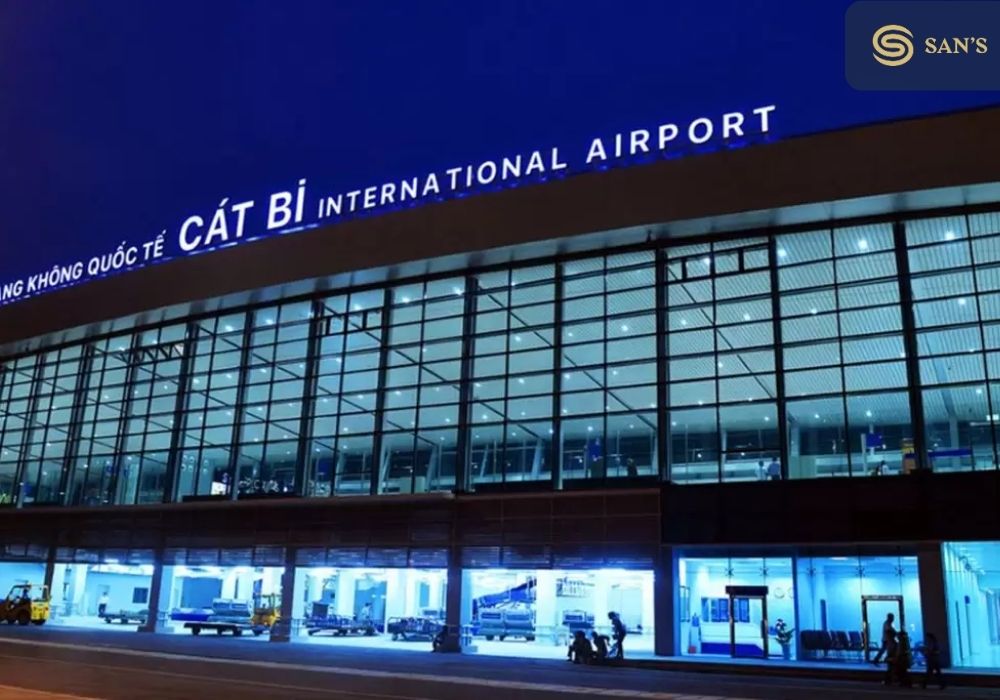
If you’re journeying from abroad or places beyond Hanoi, considering flights to Ha Long Bay is beneficial due to their convenience and time-saving nature. When flying, there are three nearby airports to Halong Bay you can choose from.
| Airports Proximate to Halong | Distance to Halong Bay | Airlines servicing this airport |
| Van Don Airport – Quang Ninh Province | 50 km | Vietnam Airlines, VietJet Air, Bamboo Airways |
| Cat Bi Airport – Hai Phong City | 60 km | Vietnam Airlines, VietJet Air, Bamboo Airways, Pacific Airlines, Donghai Airlines, Ruili Airlines, etc. |
| Noi Bai Airport – Hanoi City | 180 km | Vietnam Airlines, Pacific Airlines, VietJet Air, Bamboo Airways, AirAsia, Cathay Pacific, Hong Kong Airlines, Thai Airways, etc. |
Pros:
-
- Speed: Reach the bay in the shortest time possible.
- Convenience: Multiple daily flights from major cities.
- Comfort: Modern airports with good amenities.
Cons:
-
- Cost: Often pricier than other means.
- Limited destinations: Not all cities offer direct flights.
Roadway – The Journey Through Vietnam’s Landscape
Traveling to Halong by road is another favored option, suitable for both short and long distances. With the recent enhancements to Vietnam’s expressways, commuting via shuttle bus, limousine van, private car, taxi, or even motorbike has become more seamless. This mode allows travelers to experience the local culture while also being cost-effective.
Your choice can range from budget-friendly options to more luxurious ones based on your finances and taste. Specifically, for those coming from places like Hanoi, Sapa, Ninh Binh, and other northern Vietnam locations, we suggest considering the shuttle bus or a luxury limousine for an optimal journey experience. For those starting from central or southern Vietnam, a night bus is advisable for maximum comfort.
If you’re driving your own car, keep up to date with weather conditions and make sure you have a reliable GPS or maps!
Pros
Cons
Railway: Experience Vietnam on Tracks
If you’re looking for an authentic travel experience to Halong Bay, consider the railways. This allows you to leisurely absorb the scenery. Options range from soft/hard seats to sleeper cabins, and from local to luxury tourist trains.
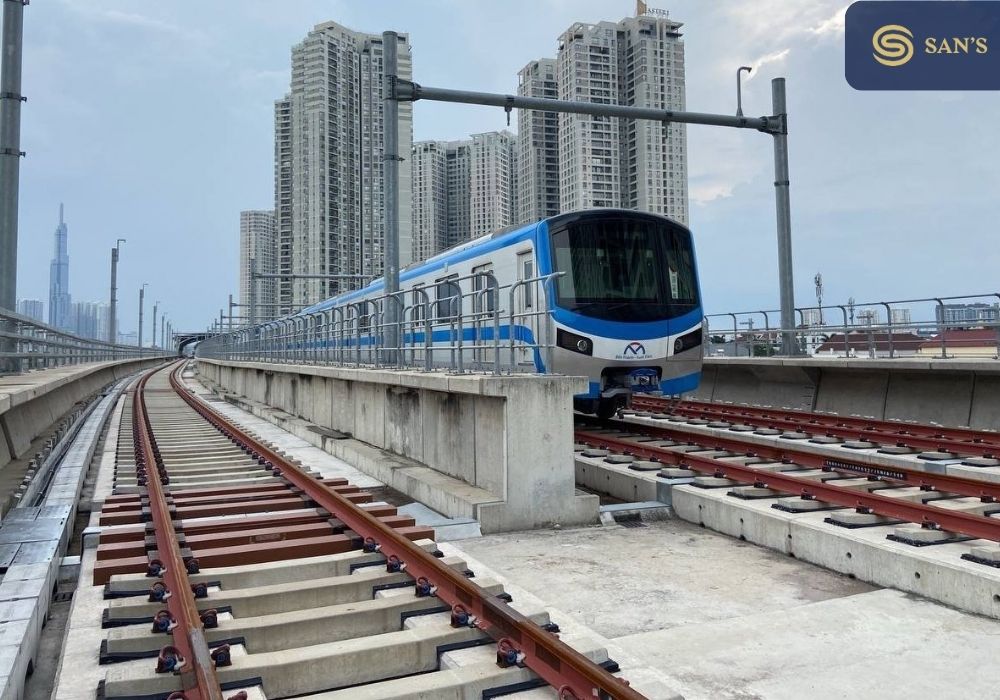
While train journeys might be lengthier compared to traveling by bus or car, they offer a comfortable environment and restful sleep on extended trips. However, it’s worth noting that train tickets tend to be pricier than bus tickets.
| Departure point | Route | Distance & Duration |
| From Hanoi – Yen Vien Train Station | Hanoi to Halong by train | 180 km in approximately 7 hours. |
| From Sapa – Lao Cai Railway Station | Sapa to Hanoi by train, then Hanoi to Halong by either road or train |
|
| From Ninh Binh – Ninh Binh Train Station | Ninh Binh to Hanoi by train, followed by Hanoi to Halong via road or train |
|
| From Da Nang – Da Nang Train Station | Da Nang to Hanoi by train, then Hanoi to Halong by either road or train |
|
| From Ho Chi Minh City – Saigon Railway Station | Ho Chi Minh City to Hanoi by train, followed by Hanoi to Halong via road or train |
|
Pros
The train is a secure mode of transportation to Halong Bay and provides a genuine, comfortable way to explore Vietnam.
Cons
The lengthy and leisurely pace of train travel might not be ideal for those with limited time.
Waterway: Sailing to the Bay
You can conveniently reach Halong Bay from neighboring areas via water routes using cruise ships, ferries, or speed boats. The most direct route is the Cat Ba – Tuan Chau Ferry, with speedboats also available from Hai Phong.
Moreover, from Hanoi, you can opt for a Halong Bay cruise to delve deeper into the beauty of this world-renowned natural heritage. Ha Long is also home to several international ports catering to both logistics and tourism.
Reaching Halong Bay from International Locations
How to get to Halong Bay from a foreign country, you’ll first need to secure a flight to Vietnam. The country’s three primary international airports are located in Hanoi, Da Nang, and Ho Chi Minh City, handling a significant volume of international traffic.
Of these, Hanoi’s Noi Bai Airport is the nearest to Halong Bay. Thus, the most practical route for international travelers is to fly directly to Hanoi, particularly for those intending to explore northern Vietnam.
Alternatively, flying into Ho Chi Minh City or Da Nang and then journeying to Ha Long Bay is also a viable choice.
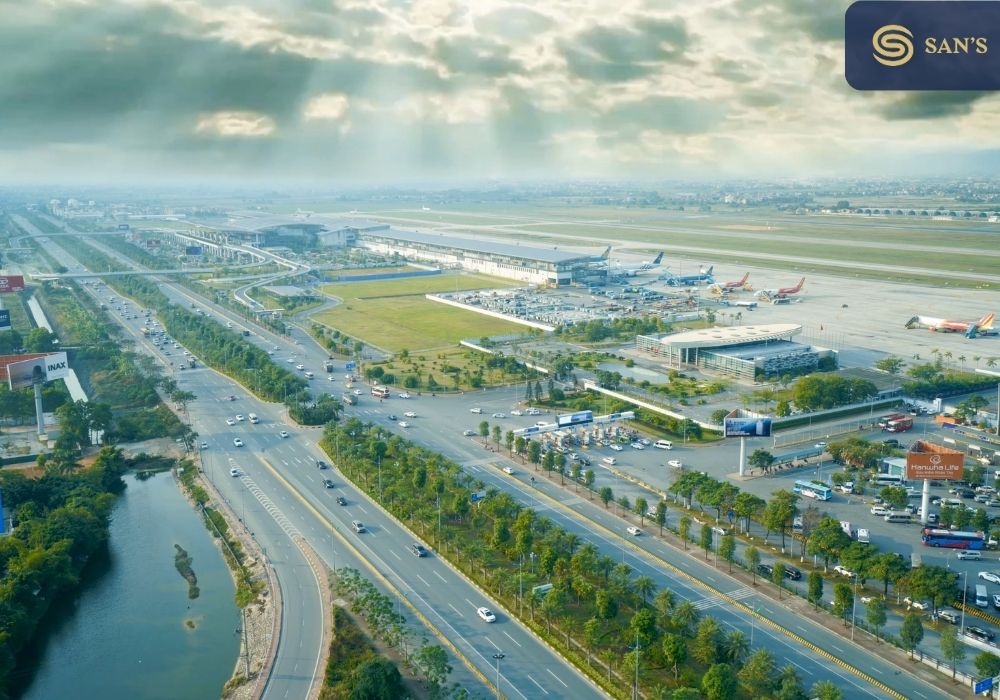
International flight routes
- From Asian nations: Examples include China, Hong Kong, South Korea, Taiwan, Thailand, Cambodia, Laos, Malaysia, Singapore, and more.
- From Western regions: Such as France’s Paris, the UK’s London, Germany’s Frankfurt, Russia’s Moscow, and so on.
- From the Americas: Cities like New York, Los Angeles, and San Francisco in the USA, or Toronto and Vancouver in Canada, among others. There’s potential for establishing direct flight routes between the USA and Vietnam soon. Don’t let the absence of direct routes to Vietnam curb your travel enthusiasm. Occasionally, taking a connecting flight to Vietnam can be more cost-effective.
Numerous connecting flights to Vietnam pass through places like Thailand, Singapore, China, Hong Kong, Seoul, and others. Here are some commonly used international flight paths from major global cities leading to areas close to Halong Bay and throughout Vietnam.
What is the price?
On average, round-trip fares to Vietnam typically range between 350 USD and 1,500 USD. Flight costs can fluctuate based on factors like the season, airline choice, cabin class, and point of departure. Traveling from the USA tends to be more expensive due to the lack of direct flights to Vietnam.
Airfares are usually more affordable in the off-peak season, which spans from May to October. Conversely, the most expensive rates can be found in December and February. Opting for budget airlines like Tiger Airways, Air Asia, Pacific Airlines, and VietJet Air can also help you save on travel expenses.
How to get to Halong Bay from a local point within Vietnam
After arriving in Vietnam, you’ll be presented with various options to determine the best method of reaching Halong Bay. No matter where you are in the country, navigating to Halong Bay is straightforward and accessible. Explore this guide to discover the top 7 travel routes within Vietnam.
Hanoi to Halong Bay
Hanoi, Vietnam’s capital, is located on the western side of the Red River in the northern part of the country. The journey between Hanoi and Halong spans approximately 170 km, taking about 3.5 hours if one takes the older National Road 18.
Yet, with the introduction of the New Highway 5B (Hanoi – Hai Phong Expressway) in early 2019, the commute time has been reduced to about 2.5 hours. Even with the proximity, determining the best route from Hanoi to Halong Bay can be perplexing.
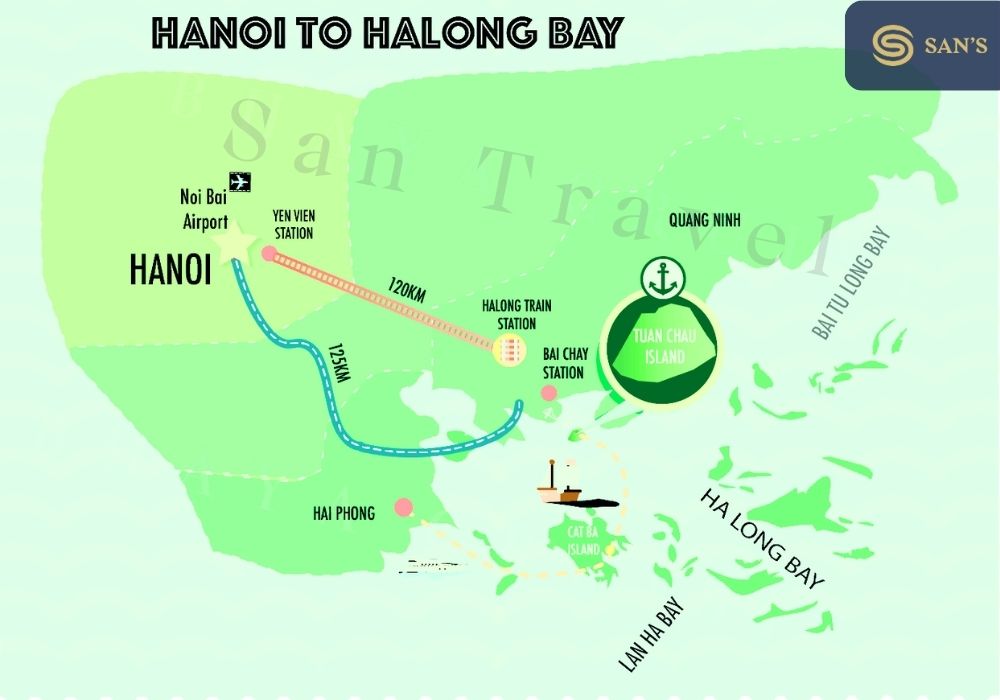
How to get to?
You have multiple options to journey to Halong, whether you prefer a local experience or a more luxurious approach. Consider one of our suggestions, each offering distinct levels of quality, cost, and comfort.
| Transport type | Time | Price |
| Bus (Shuttle bus & Limousine) | 2.5 to 3.5 hours | 5 – 15 USD |
| Private car / Taxi | 2 to 2.5 hours | 65 – 150 USD |
| Flight | 45 minutes | 180 – 400 USD |
| Train (Local train) | 7 hours | 3 – 4 USD. |
Hai Phong to Halong Bay
Hai Phong, a significant port city in northern Vietnam, borders both the land and sea of Quang Ninh province. Traveling from Hai Phong to Halong Bay is relatively short, about 63km if using the New Highway. Taking the older expressway extends the distance to nearly 90km.
Previously, road travel would take around 2 hours. With the New Highway, the journey from Hai Phong to the bay is reduced to just 1 hour. This proximity facilitates easy travel between Ha Long Bay and Cat Ba Island. However, the water route takes a longer time, exceeding 3 hours.
How to get to?
| Transport type | Time | Price |
| Bus | 1.5 hours | 5 – 10 USD |
| Taxi / private car | 1 hour | 40 – 70 USD |
| Cruise Halong Bay | 2 – 3 days | 130 USD ++ |
Sapa to Halong Bay
Sapa, nestled in the mountainous terrain of northern Vietnam, is roughly 490 km away from Halong. The exact distance might vary based on the chosen route. With the introduction of the Noi Bai – Lao Cai Expressway, the journey from Sapa to Halong Bay has become quicker and more convenient. Regardless of the path selected, travelers can expect scenic views and a pleasant journey.
Typically, the journey takes between 7 to 10 hours. Given the extended distance and the nature of the routes, the quickest travel time stands at 7 hours, categorizing it as a lengthy trip. Your choice of transportation mode will depend on the time you’re willing to allocate for travel and the number of stops you’d like to make en route.
How to get to?
| Transport type | Time | Price |
| Bus | 8-10 hours | 18 – 23 USD |
| Taxi / private car | 6-7 hours | 35 USD ++ |
| Train | 10 – 18 hours | 250 USD ++ |
Ninh Binh to Halong Bay
Ninh Binh, a province in northern Vietnam, is often referred to as “Halong Bay on land” due to its resemblance with limestone karsts, caves, and clear blue waters. Located approximately 220 km away, Ninh Binh stands as a top destination in the North for its serene landscapes and nature’s grandeur.
The journey from Ninh Binh to Halong Bay typically ranges between 3.5 to 5 hours, depending on the chosen route and mode of transportation. The recommended path is via National Route 38B, passing through Ha Nam and Hung Yen provinces, then connecting to National Highway 5B.
How to get to?
| Transport type | Time | Price |
| Bus | 4 – 4.5 hours | 15-20 USD ++ |
| Taxi / private car | 3.5 hours | 80 USD ++ |
Da Nang/ Hoi An to Halong Bay
Da Nang and Hoi An, two of the most sought-after spots in central Vietnam, are approximately 900 km and 930 km away, respectively. Given the considerable distance, options to travel between Halong Bay and Da Nang include both road and air.
A direct flight would take just over an hour. Alternatively, you can fly to closer airports in Hanoi or Hai Phong, spend some days exploring, and then proceed to the bay. On the other hand, a road journey can extend up to 16 hours, but offers the bonus of passing through many picturesque locations and potential rest stops.
How to get to?
| Transport type | Time | Price |
| Flight | 1 hour 30 minutes | 50 – 100 USD ++ |
| Overnight bus | 17 – 19 hours | 40 USD ++ |
| Overnight train | 20-21 hours | 45 USD ++ |
Ho Chi Minh City to Halong Bay
Ho Chi Minh City, renowned as the most vibrant and rapidly growing city in the South, is situated roughly 1,800 km from Ha Long Bay by road. Unlike Da Nang and Hoi An, the distance between Ho Chi Minh City and Halong Bay is substantial, but it is still possible to make the journey.
Traveling by road requires more than a day, roughly 33 hours of travel time. It’s a lengthy expedition that can leave you fatigued and uncomfortable in a car or train seat. For this reason, many tourists prefer taking a flight, which reduces the travel time to just 2 hours.
How to get to?
| Transport type | Time | Price |
| Flight | 2.5-3 hours | 90 USD ++ |
| Train | 35-37 hours | 50 – 60 USD ++ |
Hue to Halong Bay
Hue and Halong Bay are both renowned tourist destinations in Vietnam that deserve a visit. However, these two places are quite distant from each other. If you intend to explore both of these attractions, it’s important to be aware of the available travel options between Hue and Halong Bay to streamline your journey. The distance separating the two cities is approximately 765.6 km. Currently, there are no direct flights or trains connecting these two cities. Your options include taking a flight from Hue to Hanoi and then traveling from Hanoi to Halong Bay or opting for a direct bus to Halong Bay.
>>>> You might also like: Discovering Lan Ha Bay: Vietnam’s Tranquil Paradise
Recommended Travel Plan for Reaching Halong Bay
In addition to the previously mentioned modes of transportation, numerous travelers opt for a Halong Bay cruise to explore the area. Here is our guide to Halong Bay tourism, offering information on the top tours and excursions to consider, depending on the duration of your vacation.
Hanoi – Ha Long Bay – Sapa
For those with limited time who want to experience the essence of Northern Vietnam.
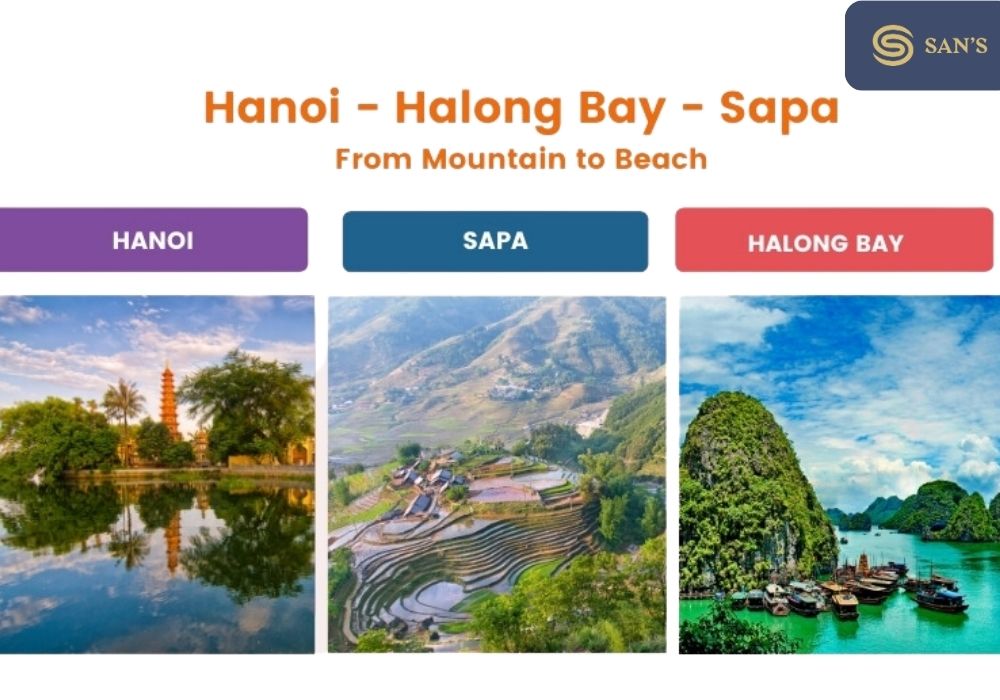
- Day 1 – Hanoi: Start your journey in the bustling capital city of Hanoi. Explore the Old Quarter, indulge in street food, and visit historical landmarks like the Hoan Kiem Lake and Hoa Lo Prison.
- Day 2 – Hanoi to Ha Long Bay: Depart early for the scenic drive to Ha Long Bay. Spend the day cruising through the breathtaking limestone karsts, enjoying a seafood feast on board, and exploring some of the bay’s famous caves.
- Day 3 – Ha Long Bay to Sapa: After returning to Ha Long City, head to Sapa by road. Enjoy the picturesque drive through the northern mountains and arrive in Sapa in the evening. Relax and soak in the stunning views.
- Day 4 – Sapa Exploration: Discover Sapa’s terraced rice fields, ethnic minority villages, and vibrant local markets. Trekking options are available for those seeking adventure.
-
Day 5 – Return to Hanoi: Drive back to Hanoi or take the overnight train to maximize your time. Spend your last evening in Hanoi reminiscing about your unforgettable journey.
Hanoi – Ninh Binh – Ha Long Bay
For travelers who want to immerse themselves in Vietnamese culture and history.
- Day 1 – Hanoi: Begin in Hanoi, exploring its rich history and vibrant culture. Visit the Ho Chi Minh Mausoleum, the Temple of Literature, and enjoy traditional water puppetry.
- Day 2 – Hanoi to Ninh Binh: Head to Ninh Binh, often referred to as “Halong Bay on Land.” Explore the stunning Trang An Landscape Complex, Tam Coc, and Bich Dong Pagoda.
- Day 3 – Ninh Binh to Ha Long Bay: After enjoying Ninh Binh’s wonders, journey to Ha Long Bay to experience its natural beauty.
- Day 4 – Ha Long Bay Exploration: Spend the day cruising the bay, kayaking, and taking in the serene ambiance.
- Day 5 – Return to Hanoi: Head back to Hanoi for your last night in Vietnam’s capital, savoring the memories of your cultural journey.
Ho Chi Minh City – Mekong Delta – Hoi An – Hue – Hanoi – Ha Long Bay
For adventurers who want to explore the length and breadth of Vietnam.
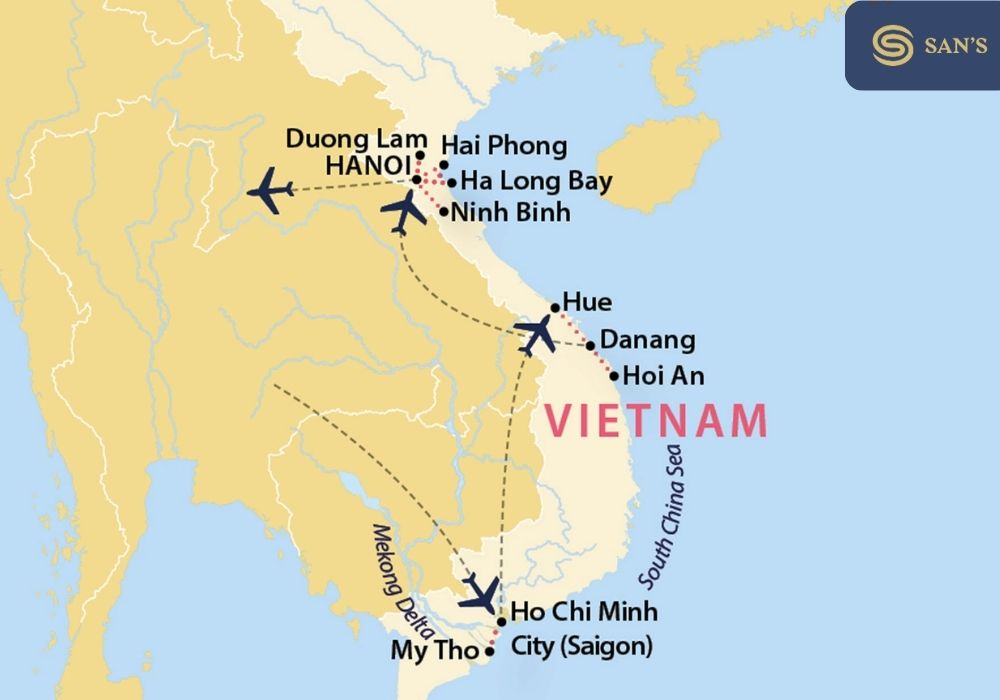
- Day 1 – Ho Chi Minh City: Start in the vibrant southern metropolis, Ho Chi Minh City. Explore historical sites like the War Remnants Museum and Notre-Dame Cathedral Basilica.
- Day 2 – Mekong Delta: Venture into the Mekong Delta, exploring its lush landscapes, floating markets, and rural life.
- Day 3 – Hoi An: Fly to Hoi An, the charming ancient town. Wander through its lantern-lit streets, visit tailor shops, and indulge in delicious local cuisine.
- Day 4 – Hue: Drive to Hue, the former imperial capital of Vietnam. Explore the UNESCO-listed Imperial City and tombs of the Nguyen Emperors.
- Day 5 – Hanoi: Fly to Hanoi and spend your day exploring its historical and cultural gems.
- Day 6 – Ha Long Bay: Embark on a journey to Ha Long Bay, where you’ll be captivated by its stunning landscapes.
- Day 7 – Ha Long Bay Exploration: Enjoy your final day cruising the bay before heading back to Hanoi for your departure.
To sum it up, there is no one-size-fits-all response to the query of “How to reach Halong Bay?” because there are numerous alternatives for travel routes, modes of transport, and transfer services. For international travelers, it is advisable to secure an international flight and engage a tour package with San Travel, as they will offer expert advice on the most suitable travel options for your needs.



Comment (0)